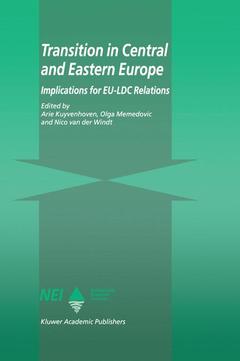Description
Transition in Central and Eastern Europe, 1996
Implications for EU-LDC Relations
EU-LDC Trade and Capital Relations Series
Coordinators: Kuyvenhoven A., Memedovic Olga, van der Windt Nico
Language: English
Subjects for Transition in Central and Eastern Europe:
Keywords
Eastern Europe; European Union (EU); Nation; development; trade policy
Publication date: 01-2013
320 p. · 16x24 cm · Paperback
320 p. · 16x24 cm · Paperback
Description
/li>Contents
/li>
In less developed countries (LDCs) there is considerable concern that the developments in the Central and Eastern European Countries (CEECs) may lead to a more inward looking European Union (EU). As EU trade, foreign investment and aid flows are diverted from LDCs towards the CEECs, close neighbours of the EU, a new dimension would be added to 'fortress Europe'. This volume consists of 11 chapters by scholars from the EU, the CEECs and LDCs. Each paper is discussed in terms of its policy relevance by a policy maker as well as by an academic specializing in the field. In the opening chapter we aim to do justice to the discussion during the Workshop in Rotterdam in May 1994 at which preliminary versions of all chapters were presented. Edited versions of the interventions by the policy makers and experts are included as far as possible after the chapters. A summary of the discussion is presented in the concluding remarks by Rolf Langhammer. The opinions expressed in this volume are those of the authors and not necessarily of their organizations. The editors XXI Foreword I am glad the first meeting of this network is on the developing country dimension of pan-European integration, for two reasons. Firstly, politi cal and economic liberalization in Central and Eastern Europe makes it possible, even necessary, to discuss such an issue.
One: Overview.- 1 Recent developments in EU-LDC relations: an overview.- 2 Are EU trade, investment and development assistance being diverted from LDCs to CEECs?.- Discussion.- Two: European Union Policies.- 3 The role of regional trade and investment agreements.- Discussion.- 4 The shaping of EU trade policies towards CEECs and LDCs.- Discussion.- 5 EU policy alternatives towards CEECs and LDCs.- Discussion.- Three: Sector Studies.- 6 EU agricultural policy towards CEECs: the impact on LDCs.- Discussion.- 7 The role of the MFA and the EAs in EU trade in textiles and clothing with LDCs and CEECs.- Discussion.- Four: Country Studies.- 8 The Europe Agreements and EU-LDC relations: the case of France.- Discussion.- The CEECs as a stepping-stone to the EU market (with particular attention to Poland).- Discussion.- 10 An inventory of Turkey’s international trade and investment agreements.- Discussion.- 11 Concluding remarks.
© 2024 LAVOISIER S.A.S.




